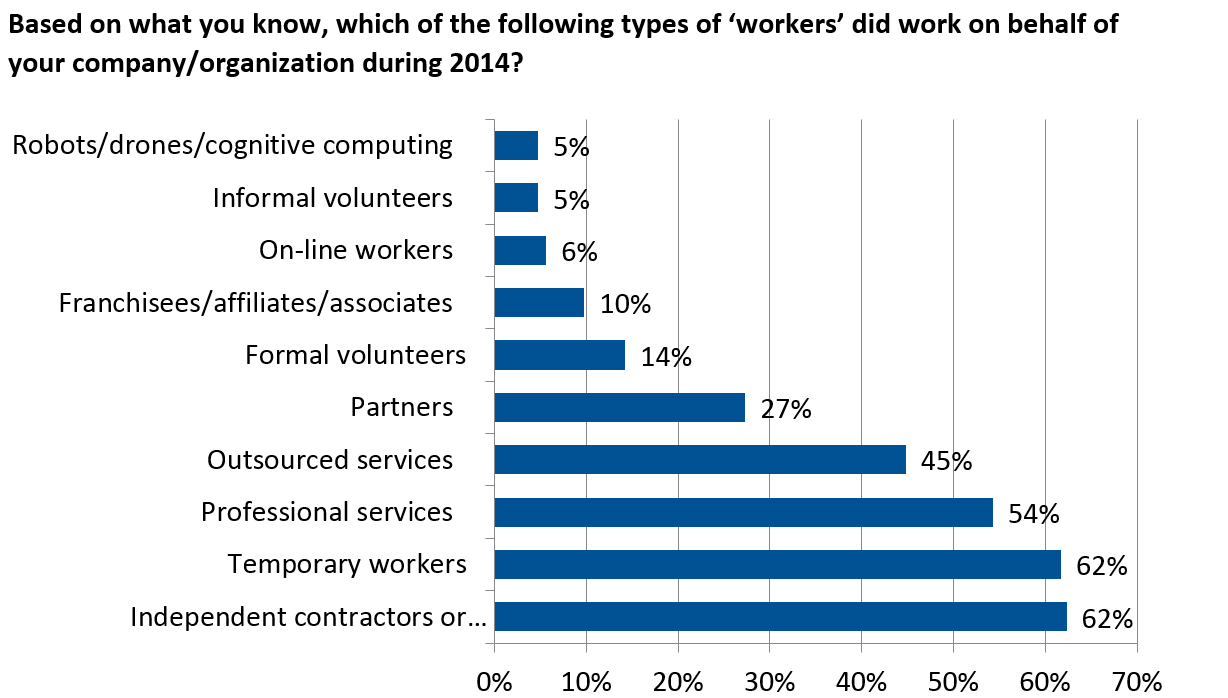Many organizations are looking to source talent directly. Freelancers are part of that talent pool. If you’re considering taking such a step, you’ll need to understand this pool and what we mean by direct sourcing.
- Direct Sourcing — A term commonly used to refer to the process by which a company leverages its own internal candidate pool (for example, former employees, retirees, applicants from own ATS) to place within the company as temporary employees, plus more now.
- Directly Sourced Contingent Workers — A service segment of the contracting/consulting industry, directly sourced contingent workers include independent contractors/ consultants, temporary workers sourced from an internal pool and others such as summer interns and seasonal workers.
- Freelancer, Independent Contractor — A self-employed individual performing services for a company under contract rather than as an employee, either on- or off-site. Unlike employees, independent contractors are free to perform their work as they see fit.
What’s this talent pool worth? According to Staffing Industry Analysts’ Global Contingent Market Estimate, the global contingent work spend estimate for independent contractors globally was $1.026 trillion and for Statement of Work it was $1.072 trillion. In Europe alone, the freelance talent pool has grown to 8.9 million workers from 6.2 million over nine years, 25% in professional, scientific and technical work and 22% in arts and entertainment. In the UK, 4.7 million were self-employed in 2013 and in Russia IT freelancers were estimated to be 35% of total labor market. Suffice to say, it’s a huge chunk of the professional labor market and well worth looking into for your talent needs.
What about the risk? When we asked buyers in our Contingent Buyers Survey about who they saw in their labor force over the next 10 years, they said their share of independent contractors/freelancers would decrease by 8%, as indicated in the chart below. Buyers perceive risk but just look at the employee types that are increasing, SOW and high-skill contingent workers.
You can bet that independent contractors and freelancers are a big part of that set of SOW and high-skill contingent workers. Smart buyers will find a way to address the risk of using this valuable set of workers through diligence with their legal counsel and knowledgeable partners.
We also asked buyers what categories of contingents did work at their company. There were just as many independent contractors as temporary workers. This gives buyers even more reasons to focus in on direct sourcing as a talent source.
Managing the Freelancer Pool
Another way buyers may engage, track and analyze independent contractors/freelancers is using freelance management system (FMS), which is defined by Staffing Industry Analysts as “a cloud-based workforce management platform. The FMS helps businesses initiate, manage, complete, track and analyze engagements with individual independent workers, who may be sourced by the provider of the business itself. An FMS can provide a complete, end-to-end technology to enable users in an organization to search for and find a particular worker and activate, complete, and pay for the work engagement within the system.”
If you want to learn more about this tool to help explore freelance management take a look at our Freelancer Management Systems (FMS) Differentiators and Competitive Landscape.
Direct sourcing and the use of independent contractors/freelancers can also support the concept of total workforce management and the development of the brand. Also, using FMS partners and MSPs to direct source independent contractors/freelancers can drive benefits in terms of efficiency, risk, quality and cost savings.
Some other things to think about when exploring freelancers and direct sourcing for your program may be around appropriate skills to direct source for (usually professional level) and geographical and financial implications. You need to know which geographies direct sourcing works better in or alternatively may not be an option legally. Alternatively, be aware that using staffing companies helps with cash flow — staffing companies pay the workers immediately, direct freelancers most likely will want to be paid immediately by your company. In general, the direct sourcing model is worth exploring, carefully. Make sure your organization has the appetite and the executive support to explore this tempting option and get greater visibility and access to a wider world of talent.











